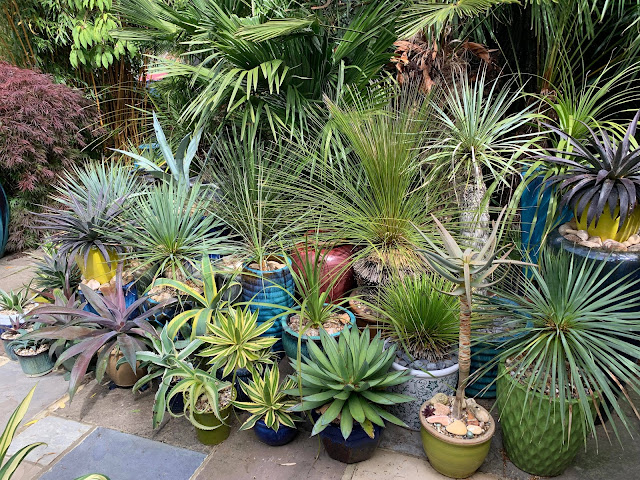A few days ago the photo below came up on my Facebook timeline, from around 2015/2016 (I think)...
It's quite a significant photo in the sense that it led to the more familiar succulent pot display we do nowadays on our top patio.
The display above was fun to do, and perhaps quirky enough that it actually made it to a gardening magazine. However, it also made me cringe looking at it shortly after....can't believe I displayed two agaves so prominently in ordinary plastic pots, and to be published too!!
Perhaps it wasn't too bad, after all we had fun doing it then. But it led to several changes:
- To never ever display plants in plastic pots so prominently ever again.
- As I fell in love with Vietnamese pottery and other glazed pots shortly after, to use them instead. They are more robust and instantly adds colour (plus I enjoy looking at the pots itself).
- Instead of using a collection of small pots, use larger ones instead that can hold bigger specimens.
- And to make a more permanent year round pot display, by using hardier spiky plants that can stay out all year
 |
| How it looks this year |
As with the last point, the display above consisted mostly of non hardy succulents that needed shifting under cover before the first frosts arrive. The sheer volume made moving them in and out very time consuming and impractical. So a more permanent display of hardier spiky plants made less work and provided interest on the top patio all year round.
On a more poignant note, whatever happened to most of those succulents in those tiny pots? Most of them are gone now, they perished in the autumn that followed that summer. It was also a period wherein both of us became exceptionally busy at work then when the time came that they needed shifting, neither of us could do it before the first frosts arrived. It was a little heart breaking that they had to be sacrificed due to lack of time. So another important lesson: finding a balance between what spare time you have available with the kind/amount of plants you acquire. We have since moved on....
Anyway, on a more contemporary note., I took the photo above yesterday of our 'spiky jungle' area. I thought it looked alright, but Gaz spotted the pot on top of the pillar, saying how much of a non entity it was. So he's thinking of replacing it with a bigger vessel/urn with a plant in it.
I say go ahead, bring it on!
Mark :-)



 This gardening blog follows our journey as we create our Tropical and Exotic themed garden. We hope you'll enjoy the journey as much as we do. We started our Exotic Garden in 2005 and this site will show its development, as well as our travels, both abroad and within the UK to gardens, nurseries and friends.
This gardening blog follows our journey as we create our Tropical and Exotic themed garden. We hope you'll enjoy the journey as much as we do. We started our Exotic Garden in 2005 and this site will show its development, as well as our travels, both abroad and within the UK to gardens, nurseries and friends.






